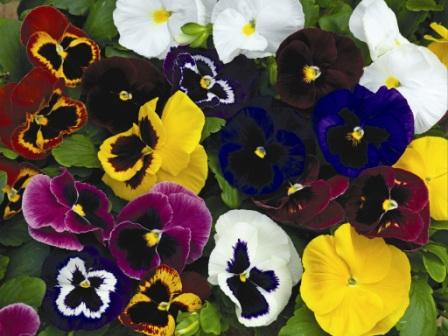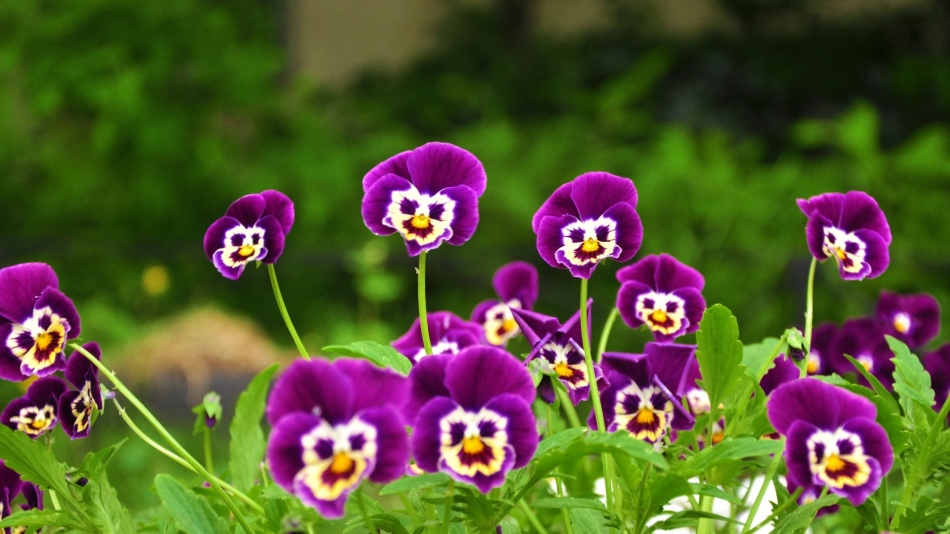 Bright variegated viola flowers adorn flowerbeds, gardens, parks, balconies and summer cottages. She is a relative of violets and is very similar to her. When and how to plant viola seeds for seedlings this year, what kind of care is needed for seedlings and how to grow garden violets?
Bright variegated viola flowers adorn flowerbeds, gardens, parks, balconies and summer cottages. She is a relative of violets and is very similar to her. When and how to plant viola seeds for seedlings this year, what kind of care is needed for seedlings and how to grow garden violets?
Content
Viola planting dates in 2018
Viola herbaceous, low plant 20-30 cm tall with a single flower on a spur. Spotted, striped, simply plain flowers in diameter from 4 cm to 10 cm have a rich color scheme. The violet family has about 400 different plant species. Representatives of this family are annual, biennial and perennial.
Pansies do not require complicated care. They can be transplanted even during flowering. Flowers appear in March or August and stand until the first frost. The plant prefers sunny areas, although it also tolerates partial shade. In the shade, the flowers become smaller than in the sun.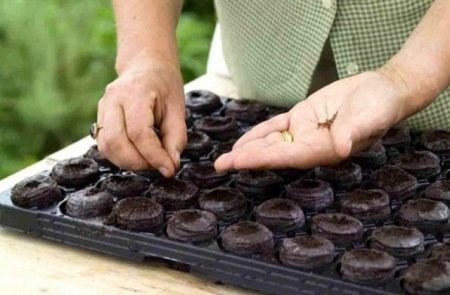
Sowing seeds is best done in late winter or early March. Turning to the lunar calendar, in 2018, the days from February 22 to February 27 inclusive are considered favorable for planting a viola for seedlings. It is not advisable to plant seeds on February 14-16. In March, you can plant seed all month except for a few days: 2.13-15. Early seed planting will give flowering already in late summer, and the next season the viola will bloom in March.
You can sow seeds immediately in open ground, this is done in May - June, the soil should warm up well. Viola will bloom in the fall, and the first snow will cover the flowers. In May 2018, seeds are planted from the 1st to the 6th, from the 9th to the 14th, and the 30.31th of the seeds. Favorable days for landing in June: 14-15, 18-27.
For wintering, sow seeds in open soil at the end of summer. In August, the most suitable numbers for seeding are: 4-7, 18-24.
There are three ways to plant a viola:
- Seed planting method for seedlings in late winter or early spring. Plants will bloom in mid-summer.
- Sunflower seeds can be sown immediately in open land at the beginning of the summer period. Flowers bloom in early autumn.
- Sowing seeds in autumn in September. Flowering will be in the spring.
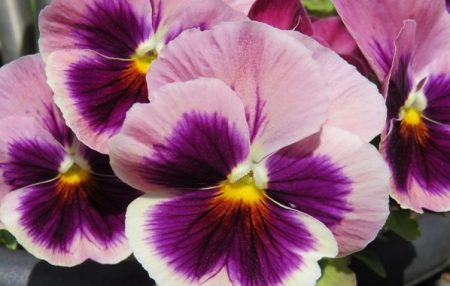
Planting seeds for seedlings
It is important to choose fresh seed for planting, with each year the seeds lose about 20% of their germination. They are stored no more than 4 years. Therefore, paying attention to the expiration date, it is better to take a bag with the date of the previous year.
The earth mixture for viola can be purchased at the store, it is better to take a mixture for violets or prepare it yourself. For the substrate they take: land (can be taken from the garden), humus, sand and peat (2: 2: 1: 2). The cooked earth should be calcined in the oven for about 3 hours. This will kill fungi and viruses in the soil. The soil environment is not higher than pH 5.8.
The seed is soaked before planting in Epin's solution and left for 24 hours.
The boxes are filled with prepared soil, moistened and made small indentations of 0.5 cm, the distance between the holes is about 2 cm. The seeds are placed in holes and covered with soil. The soil is moistened from above, but not flooded with water, in order to prevent rotting of the rhizome.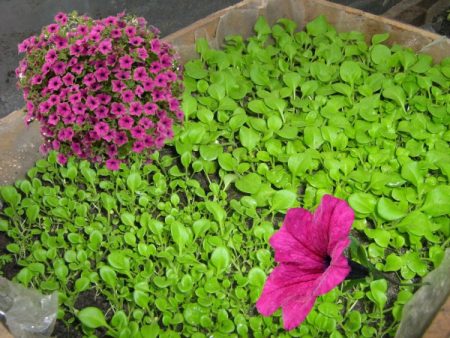
For rapid germination of seedlings, containers are covered with foil material and moved to a warm room (temperature 20 - 25 degrees). Until the sprouts appear, lighting is optional. To avoid mold, from time to time the film is removed, the ground is periodically sprayed with water.
The first shoots will break through in a couple of weeks. Containers in this period rearrange to bright places, but not under direct sunlight. Young plants may turn yellow and die.The temperature for the flowers is maintained no higher than 10 degrees of heat, so that the seedlings do not go quickly to growth. The film is removed three weeks after sowing the seeds.
Another practical method: growing seedlings in peat tablets. They are soaked in water, seeds are placed in the swollen tablets, they are lightly covered with soil and watered. Due to the nutrient medium, seed survival in such an environment is very high.
Picking seedlings
Young growth is transferred to separate pots when they have a few leaves. Mineral additives are added to the new soil, natural products can be used: crushed eggshells (1 tsp), banana skins (2 tbsp).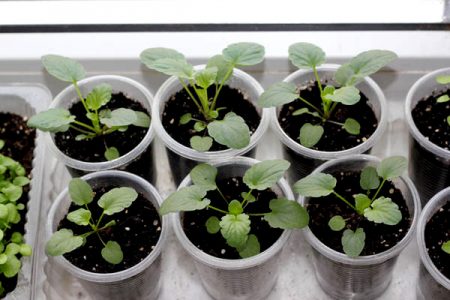
Glasses or pots should be with drainage holes and at least 250 ml in volume. A little drainage is poured into the bottom, fertilized soil is added and the seedlings are deepened by 1-2 cm. In order for the seedlings not to stretch very much, during a dive they are buried in the soil to the first leaves. As a result of this procedure, additional roots form in the plant, seedlings do not fall over and develop better.
The first top dressing for viola occurs two weeks after diving seedlings. You can make liquid organic fertilizer.
Seedling Care
In order for the seedlings to grow stronger, you need to know a few simple rules for caring for the viola:
- Make sure that the earth does not dry out, timely and moderately water.
- Twice a month to make mineral and organic top dressing (make alternately).
- Diffuse lighting and daylight hours 16 hours.
- The temperature regime is 18-20 degrees.
If the stems of the seedlings are very elongated, then you need to take measures:
- the temperature in the room is reduced to 12-14 degrees;
- increase daylight hours;
- reduce the frequency of watering;
- pinch the root of the root system for a couple of centimeters.
These measures stimulate the growth of lateral shoots, and a compact and neat bush is obtained. To form a lush bush, viols pinch the central shoot of the plant. This is done before watering. By this time, 6-7 leaves should form on the plant. When the lateral stems grow, they are pinched at a height of 4 cm.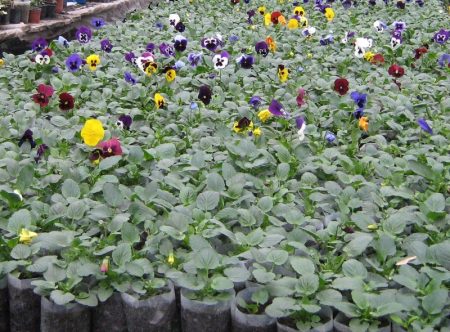
Planting seedlings in open soil
About 2 weeks before the flowers are planted in the garden, the seedlings are hardened: the boxes are taken out for several hours a day.
In May, stronger seedlings are transferred to open soil. Landing is carried out according to the scheme of 15 cm by 20 cm. 0.2 parts of charcoal and 0.2 parts of humus are added to 1 part of the soil in the holes. Together with the land in which they grew, young animals are transplanted into holes, slightly compact the soil and watered.
By mid-September, viola bushes will grow, some varieties will bloom in the autumn of the first year of life, others only in the spring of next year. Plants will winter under the snow, in spring abundant flowering will be in March.
Flower care
It’s not difficult to take care of the plants in the garden. It is necessary:
- regular loosening of the soil;
- moderate and constant moistening of the earth;
- removal of dry inflorescences will give new flowers growth; if this is not done, then the bush will soon completely remain without inflorescences.
- once a month, feed the bushes with a solution of ammonium nitrate, or superphosphate (per 1 square meter 30 g), the additives should contain: nitrogen, phosphorus and potassium.
- weeding grass around the bushes.
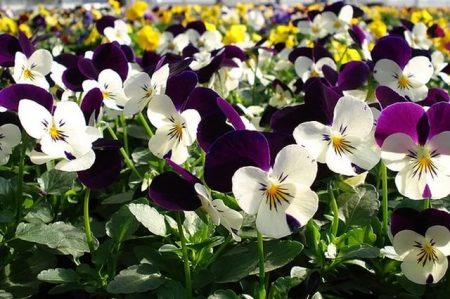
Other ways to grow Pansies
In addition to seed planting, the violet can be grown by dividing the bush, cuttings and branches.
Bushes are divided in the summer at any time, the plant will not be affected even during flowering. Separation is carried out carefully so as not to damage the roots. Plants are planted in wells and watered. New bushes will quickly fill empty areas in the garden.
If you shade Pansies, the shoots will quickly begin to stretch and you can gently pinch them to the ground next to the bush, cuttings will soon take root. It is better to do this in the middle of summer, in the spring, finished plants are transplanted to new sites.
Leaving a few dry inflorescences on the bushes, the ripened seeds will fall and germinate near the mother bush. Samosev is another way of reproduction.
Cuttings are cut off from an adult plant in July; there must be at least three internodes on them. Petioles are planted tightly to each other to a depth of 1 cm in moist soil. After regular watering, a month later, rooted cuttings are transplanted to a new place. They will have flowers next year.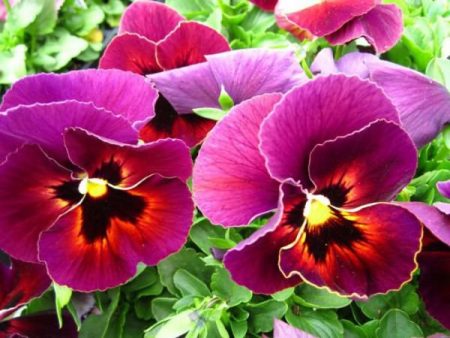
What varieties to choose for planting
There are a lot of types of viola that are cultivated in parks and gardens. The main ones: graceful, mountainous, marsh, Altai, hairy, motley, dog, etc.
Famous Viola Pansies or Wittrock – plants of this species are mostly biennial. One-color varieties of Wittroki: Blue Boy, Rua de Negri and viola white and red. Two-color hybrids: Jupiter, Lord Beaconsfield, Send Knut. Spotted varieties: Shalom Purim, Tiger Eyes, Cassis.
Ampelic or horned viola painted in purple, lilac, yellow and white, in the middle is a yellow eye. Popular hybrids: Altona, Bambini, Arkray Ruby, Balmont Blue, Simple Duet. Ampel viols are able to create voluminous spherical compositions, so they are often used in hanging flowerpots on loggias, in arbors, in cottages.
Fragrant violet can be found in early spring in forest belts, parks, gardens. They exude a pleasant aroma, flowers of purple colors. The main varieties: Rosina, Charlotte, Tsar, RedCharm, Triumph.
Viola capybara or moth, mostly flowers are painted in pale purple with a white center and dark blue veins. Varieties of this type: Freckles, RoyalRobe, Red Giant.
Most of the viola varieties are frost-resistant, but during severe frosts, some plants may die and the decorativeness of the remaining bushes will decrease. It is necessary to cut flower stalks in October, leaving several outlets, then the flowers will more easily tolerate winter cold.

